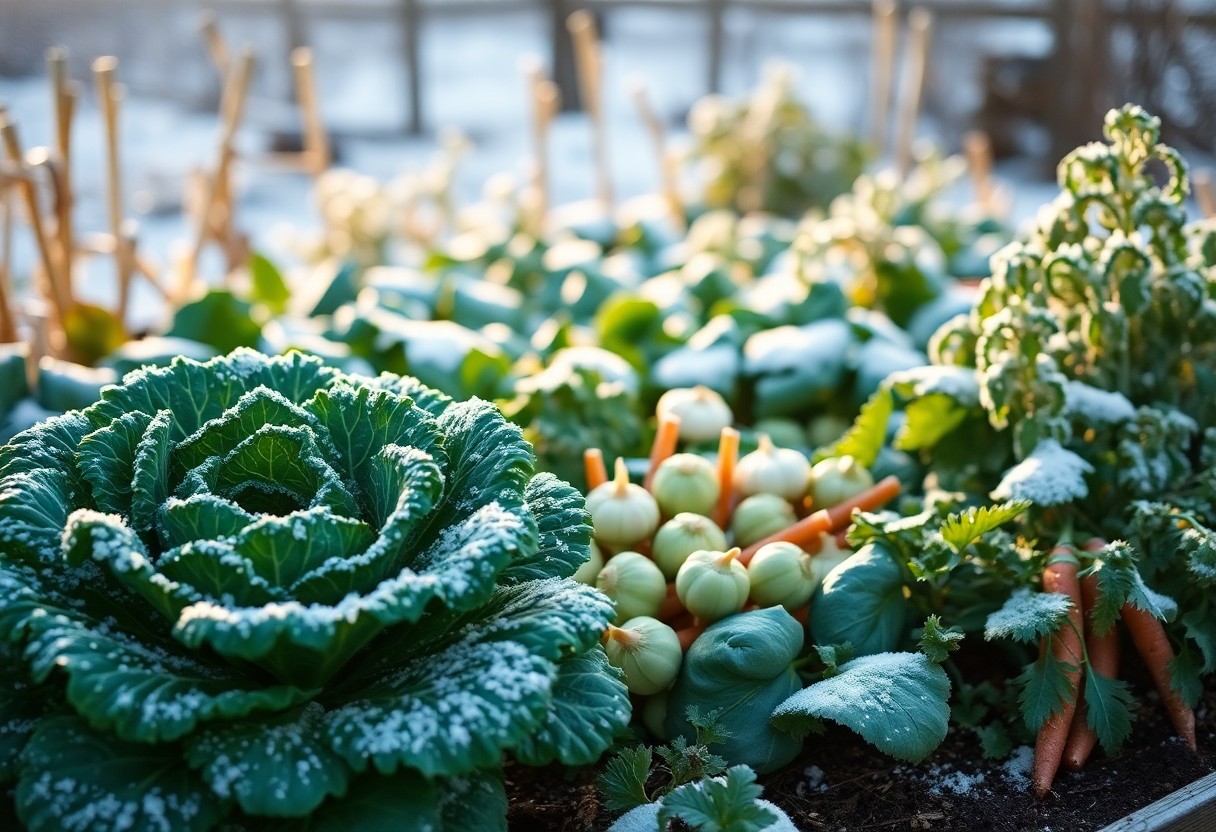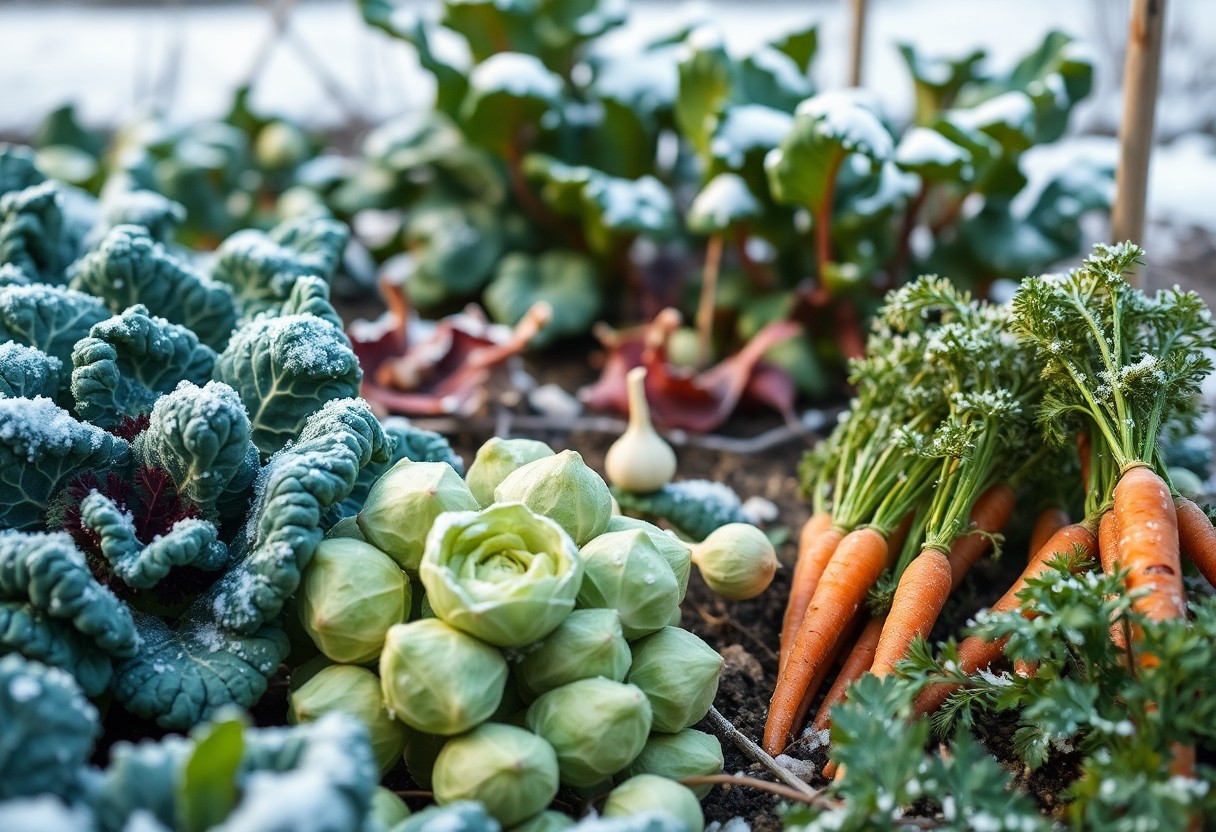Winter gardening can be incredibly rewarding, allowing you to enjoy fresh nutritious vegetables even in colder months. If you want to experience the joy of harvesting your own crops when temperatures drop, you’ll need to choose hardy varieties that thrive in frost. With the right planning and care, you can cultivate winter vegetables like kale, carrots, and spinach, which not only withstand the chill but also taste even better after a frost. This guide will help you discover the best vegetables to grow this winter, ensuring a successful cold-weather harvest.

Key Takeaways:
- Cold-hardy vegetables such as kale, carrots, and Brussels sprouts thrive in winter conditions, providing fresh produce even in colder months.
- Using protective measures like row covers or tunnels can enhance the growth of winter vegetables and extend the harvest period.
- Soil preparation and planting timing are important for a successful winter garden, ensuring that vegetables are established before the harshest winter weather arrives.
Benefits of Growing Vegetables in Winter
For many gardeners, growing vegetables in winter can be a rewarding experience. This practice not only extends your growing season but also allows you to enjoy fresh produce during the colder months. Moreover, winter vegetables tend to be hardier, which means they can withstand challenging weather conditions. By cultivating your own crops, you can enjoy a sense of achievement and self-sufficiency while contributing positively to your diet and the environment.
Nutritional Advantages
Vegetables grown in winter are often richer in vital nutrients, as they thrive in cooler temperatures. This can lead to an increase in antioxidants, vitamins, and minerals. By incorporating winter vegetables into your meals, you enhance your overall health and immune system, particularly important during the cold season when illnesses often spike.
Environmental Impact
Against common misconceptions, growing vegetables in winter can significantly reduce your carbon footprint. By growing your own food, you decrease the need for transported produce, which often involves long-distance shipping and contributes to greenhouse gas emissions. Additionally, winter crops can enhance soil quality, as they prevent erosion and promote biodiversity.
Plus, winter gardening practices can create a positive environmental impact by supporting local ecosystems. When you grow winter vegetables, you’re likely to attract beneficial insects and promote a habitat for various wildlife. Furthermore, cultivating your garden during the winter can help establish a robust soil environment since organic matter is added continuously. This leads to healthier, more sustainable gardens that benefit not only you but the planet as well.
Best Vegetables for Cold Weather
Some of the best vegetables to thrive in cold weather include leafy greens, root vegetables, and hardy brassicas, all of which can withstand frost and provide you with a wholesome harvest during winter. These varieties not only survive chillier temperatures but can also taste sweeter after exposure to frost. Whether you’re a seasoned gardener or a beginner, these vegetables can easily fit into your winter gardening plans, helping you enjoy fresh produce all season long.
Leafy Greens
Weather conditions in winter can be harsh, yet leafy greens like kale, spinach, and Swiss chard are exceptionally resilient. These vegetables provide you with a nutrient-rich option for harvesting in cold weather. Planting them in an area with good sunlight will ensure their growth, and utilizing protective coverings can help shield them from the elements.
Root Vegetables
Behind the scenes, root vegetables like carrots, beets, and turnips can actually improve in flavor when exposed to cold temperatures. These vegetables continue to grow beneath the frost, allowing you to harvest them when you need to. Their hardiness makes them the perfect choice for winter gardening, and they can be stored for extended periods, offering you a sustainable harvest.
Vegetables like carrots and parsnips not only endure colder climates but also become more sweeter after a frost. By growing them, you can enjoy a bounty of nutritious options throughout the winter months. Additionally, root vegetables are relatively low-maintenance, requiring minimal care and attention. Ensure you keep the soil well-drained and free of weeds to promote healthy growth and maximize your harvest.
Preparing Your Garden for Winter Planting
All successful winter gardening begins with careful preparation of your garden space. To ensure a thriving cold-weather harvest, you need to create an environment that nurtures your plants while protecting them from harsh winter conditions. This involves properly amending the soil, selecting the best location, and implementing effective protective measures. By taking these steps, you’ll set the stage for a productive winter growing season.
Soil Preparation
Between the elements of nature and the needs of your plants, soil preparation is a fundamental step in winter gardening. Start by testing your soil’s pH and nutrient levels to determine what amendments you may need. Incorporating organic matter, such as compost, will enhance soil structure, improve drainage, and boost fertility, creating a rich foundation for your winter crops.
Choosing the Right Location
Among the factors affecting your winter garden’s success, selecting the right location plays an necessary role. Look for spots that receive maximum sunlight during the day and are shielded from harsh winds. Aim for areas that are naturally warmer, such as near a south-facing wall or in a sheltered corner of your yard, to provide your winter crops with a better chance at thriving despite the cold.
Understanding your garden’s microclimates is vital for successful winter planting. Each area of your garden may experience different weather conditions; for instance, spots that enjoy sunlight in winter often stay warmer than shaded zones. Consider the positions of your other plants and structures when assessing sunlight exposure. This will help you to select the best spot that promotes growth while mitigating frost risks, allowing your vegetables to flourish even in the colder months.
Winter Gardening Techniques
Once again, you can extend your gardening season by using effective winter gardening techniques. These methods not only ensure the survival of your plants but also help you enjoy fresh produce all winter long. Techniques such as utilizing greenhouses or cold frames, applying mulch, and providing insulation can significantly enhance your garden’s productivity during the colder months.
Greenhouses and Cold Frames
Before plunging into winter gardening, consider creating a controlled environment with greenhouses or cold frames. These structures trap heat and moisture, allowing you to grow more sensitive crops that would otherwise struggle in frigid conditions. With proper ventilation and sunlight exposure, you can effectively maximize your winter harvest.
Mulching and Insulation
For a successful winter garden, the application of mulch and insulation is key. Mulching effectively protects root systems from extreme cold, while also conserving soil moisture. Insulation techniques can further safeguard your plants against frost damage, helping to create a more stable environment for growth all season.
Insulation plays an important role in your winter gardening success by protecting delicate plant roots from the harsh elements. For optimal results, use a layer of organic mulch such as straw, leaves, or pine needles to cover your soil. This not only provides warmth but also helps regulate soil temperature and moisture levels. Pay attention to the depth of your insulation; too little won’t provide adequate protection, while too much might suffocate your plants. By incorporating these insulation techniques, your winter garden can thrive, providing you with a fruitful and rewarding harvest despite the chilly weather.

Maintaining Your Winter Garden
Unlike summer gardens, your winter garden requires specific care to thrive in colder temperatures. Regular attention to your plants will help ensure they remain healthy and productive. You’ll need to monitor the moisture levels and keep an eye on any potential pests. Incorporating season-appropriate techniques will maximize your cold-weather harvest.
Watering Tips
An effective watering schedule is crucial for your winter garden.
- Water early in the day to prevent evaporation.
- Ensure the soil remains moist, but not overly soggy.
- Use a drip irrigation system to provide consistent moisture.
Assume that your plants require less water during winter, as cooler temperatures can reduce evaporation rates.
Pest Control Strategies
One effective way to maintain your winter garden is by employing smart pest control strategies. Winter can bring unique pests that might seek refuge in your plants. You should regularly inspect your garden for signs of infestations and use natural solutions, such as Neem oil or insecticidal soap, to combat any unwelcome guests. Keep your garden tidy by removing debris and weeds, as they can harbor pests. Fostering a healthy balance of beneficial insects can also help, as these natural predators target harmful pests and maintain your garden’s ecosystem.
Harvesting and Storing Winter Vegetables
To ensure you get the most out of your winter vegetable garden, understanding the correct methods of harvesting and storing is vital. Vegetables like kale, carrots, and Brussels sprouts can be harvested throughout the winter, depending on your local climate. Proper timing of these tasks allows for optimal flavor and preservation of nutrients, enabling you to enjoy fresh produce even in the cold months.
Timing Your Harvest
About two weeks before the first frost is an excellent time to harvest many winter vegetables, as this enhances their sweetness. However, certain hardy crops can remain in the ground, improving their flavor after a light frost. Keep a close eye on weather forecasts to determine the best time for harvesting.
Storage Methods
Between different vegetables, proper storage methods vary but are all designed to extend shelf life. Cool, dark places are typically ideal, but specific techniques like root cellaring or freezing can help maintain freshness and flavor. Using breathable bags or containers ensures air circulation, which reduces spoilage.
Your method of storing winter vegetables can significantly affect their longevity and quality. Carrots and beets can benefit from being stored in slightly moist sand, while leafy greens like kale should be kept in a sealed container in the refrigerator for optimal freshness. Avoiding excess moisture is vital since it can lead to mold, while maintaining a stable temperature protects against spoilage. By employing these techniques, you maximize both the nutritional value and flavor of your winter harvest.
FAQ
Q: What vegetables can I successfully grow in winter?
A: During winter, you can grow a variety of hardy vegetables. Some of the best options include kale, spinach, carrots, brussels sprouts, and garlic. These plants are known for their ability to withstand colder temperatures and can often thrive with minimal protection.
Q: How can I protect my winter vegetables from frost?
A: To protect your winter vegetables from frost, consider using row covers, cold frames, or cloches. These options provide a layer of insulation that can help maintain warmth. Additionally, mulching around the base of the plants can help retain soil heat and protect the roots during freezing temperatures.
Q: What is the best time to plant winter vegetables?
A: The best time to plant winter vegetables varies by region but generally, it’s ideal to sow seeds in late summer to early fall. This timing allows the plants to establish their roots before the onset of winter. For some crops, like garlic, planting can be done in late fall, just before the ground freezes.
Q: Can I grow winter vegetables in containers?
A: Yes, many winter vegetables can be successfully grown in containers. Plants like lettuce, spinach, and kale do well in pots and can be moved to protect them from extreme weather. Ensure that the containers have proper drainage and use a high-quality potting mix to support growth.
Q: Do winter vegetables taste better than those grown in warmer months?
A: Many gardeners find that winter vegetables, particularly leafy greens and root vegetables, develop a sweeter flavor as the cold weather can enhance their natural sugars. Additionally, the stress of colder temperatures can often result in a more robust taste profile for certain varieties, making them a delightful addition to winter meals.
